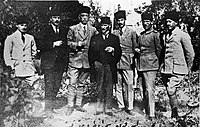
The Treaty of Sèvres was a 1920 treaty signed between the Allies of World War I and the Ottoman Empire. The treaty ceded large parts of Ottoman territory to France, the United Kingdom, Greece and Italy, as well as creating large occupation zones within the Ottoman Empire. It was one of a series of treaties that the Central Powers signed with the Allied Powers after their defeat in World War I. Hostilities had already ended with the Armistice of Mudros.

The Turkish War of Independence was a series of military campaigns and a revolution waged by the Turkish National Movement, after parts of the Ottoman Empire were occupied and partitioned following its defeat in World War I. It resulted in the collapse of the Ottoman Empire, the abolition of the Turkish monarchy and of the Islamic Caliphate, and declaration of the Republic of Turkey in Anatolia and Eastern Thrace. The conflict was between the Turkish Nationalists against Allied and separatist forces over the application of Wilsonian principles in post-war Anatolia and Eastern Thrace. In addition, it resulted in a transfer of vested sovereignty from the sultan-caliph to the nation, setting the stage of Republican Turkey's period of radical reform.

Eyalets, also known as beylerbeyliks or pashaliks, were a primary administrative division of the Ottoman Empire.

Mahmud Celâleddin "Celâl" Bayar was a Turkish economist and politician who was the third president of Turkey from 1950 to 1960; previously he was the prime minister of Turkey from 1937 to 1939.
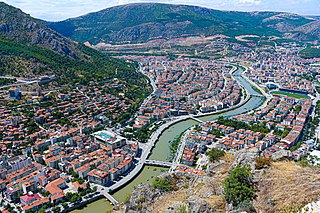
Amasya is a city in northern Turkey, in the Black Sea Region. It was called Amaseia or Amasia in antiquity. It is the seat of Amasya Province and Amasya District. Its population is 114,921 (2021). Amasya stands in the mountains above the Black Sea (Karadeniz) coast, set apart from the rest of Anatolia in a narrow valley along the banks of the Yeşilırmak River. Although near the Black Sea, this area is high above the coast and has an inland climate, well-suited to growing apples, for which Amasya province, one of the provinces in north-central Anatolia Turkey, is famed. It was the home of the geographer Strabo and the birthplace of the 15th century Armenian scholar and physician Amirdovlat Amasiatsi. Located in a narrow cleft of the Yeşilırmak (Iris) river, it has a history of 7,500 years with many traces still evident today.

The Second Constitutional Era was the period of restored parliamentary rule in the Ottoman Empire between the 1908 Young Turk Revolution and the 1920 dissolution of the General Assembly, during the empire's twilight years.

The Turkish National Movement included political and military activities of the Turkish revolutionaries that resulted in the creation and shaping of the modern Republic of Turkey, as a consequence of the defeat of the Ottoman Empire in World War I and the subsequent occupation of Constantinople and partitioning of the Ottoman Empire by the Allies under the terms of the Armistice of Mudros. The Turkish revolutionaries rebelled against this partitioning and against the Treaty of Sèvres, signed in 1920 by the Ottoman government, which partitioned portions of Anatolia itself.
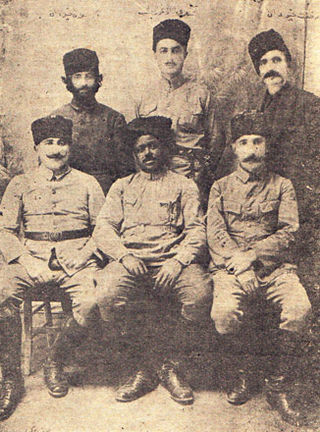
The Karakol society, was a Turkish clandestine intelligence organization that fought on the side of the Turkish National Movement during the Turkish War of Independence. Formed in November 1918, it refused to merge itself with Association for the Defense of the Rights of Anatolia and Rumelia under Mustafa Kemal Atatürk. Its leadership was decapitated in the aftermath of the 1920 Turkish Grand National Assembly election, leading to its eventual dissolution in 1926.

Misak-ı Millî is the set of six decisions made by the last term of the Ottoman Parliament. Parliament met on 28 January 1920 and published their decisions on 12 February 1920.

The partition of the Ottoman Empire was a geopolitical event that occurred after World War I and the occupation of Istanbul by British, French, and Italian troops in November 1918. The partitioning was planned in several agreements made by the Allied Powers early in the course of World War I, notably the Sykes–Picot Agreement, after the Ottoman Empire had joined Germany to form the Ottoman–German Alliance. The huge conglomeration of territories and peoples that formerly comprised the Ottoman Empire was divided into several new states. The Ottoman Empire had been the leading Islamic state in geopolitical, cultural and ideological terms. The partitioning of the Ottoman Empire after the war led to the domination of the Middle East by Western powers such as Britain and France, and saw the creation of the modern Arab world and the Republic of Turkey. Resistance to the influence of these powers came from the Turkish National Movement but did not become widespread in the other post-Ottoman states until the period of rapid decolonization after World War II.

Erzurum Congress was an assembly of Turkish Revolutionaries held from 23 July to 4 August 1919 in the city of Erzurum, in eastern Turkey, in accordance with the previously issued Amasya Circular. The congress united delegates from six eastern provinces (vilayets) of the Ottoman Empire, many parts of which were under Allied occupation at the time.
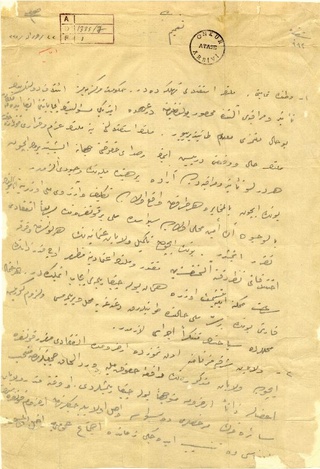
Amasya Circular was a joint circular issued on 22 June 1919 in Amasya, Sivas Vilayet by Fahri Yaver-i Hazret-i Şehriyari Mirliva Mustafa Kemal Atatürk, Rauf Orbay, Miralay Refet Bele and Mirliva Ali Fuat Cebesoy. And during the whole meeting, Ferik Cemal Mersinli and Mirliva Kâzım Karabekir were consulted with telegraphs.
Amasya Protocol was a memorandum of understanding signed on 22 October 1919 in Amasya, Turkey between the Ottoman imperial government in Istanbul and the Turkish revolutionaries aimed at seeking ways to preserve national independence and unity through joint efforts. It also signified a recognition by the Ottoman government of the rising Turkish revolutionary forces in Anatolia.

Bekir Sami Bey was a Turkish politician of Ossetian origin. He served as the first Minister of Foreign Affairs of Turkey during 1920–1921.
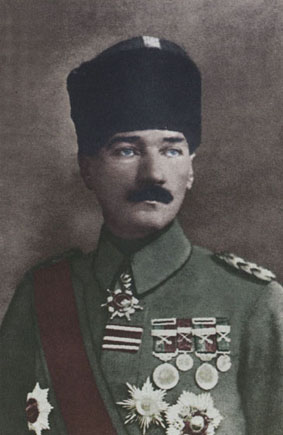
Mustafa Kemal Atatürk was a field marshal, revolutionary statesman, and founder of the Republic of Turkey as well as its first president. Mustafa Kemal Atatürk's military career explains his life between graduation from Ottoman War College in Istanbul as a lieutenant in 1905 to his resignation from the Ottoman Army on 8 July 1919, as well as his military leadership throughout the subsequent Turkish War of Independence.
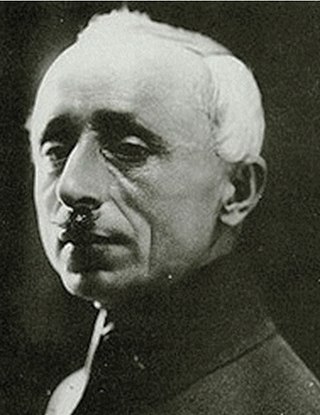
Refet Bele, also known as Refet Bey or Refet Pasha was a Turkish military commander. He served in the Ottoman Army and the Turkish Army, where he retired as a general.
General elections were held in the Ottoman Empire in 1919 and were the last official elections held in the Empire. Due to the dearth of political parties, the elections were dominated by the Association for Defence of National Rights (A-RMHC), which consisted of nationalist local groups protesting against the Allied occupation of Turkey.

The Committee of Union and Progress (CUP), later the Union and Progress Party, was a revolutionary organization and political party active between 1889 and 1926 in the Ottoman Empire and the Republic of Turkey. The foremost faction within the Young Turk movement, it instigated the 1908 Young Turk Revolution, which ended absolute monarchy and began the Second Constitutional Era. From 1913 to 1918, the CUP ruled the empire as an authoritarian one-party state and committed genocides against the Armenian, Greek, and Assyrian peoples as part of a broader policy of ethnic erasure during the late Ottoman period. The CUP was associated with the wider Young Turk movement, and its members have often been referred to as Young Turks, although the movement produced other political parties as well. Within the Ottoman Empire its members were known as İttihadcılar ('Unionists') or Komiteciler ('Committeemen').

Ahmet Hamdi Apaydın was a Turkish politician. His name during the Ottoman era was Miralayzade Ahmet Hamdi But after the Surname Law in Turkey in 1934, he took the surname Apaydın and dropped the epithet Miralayzade.
Associations for Defence of National Rights were regional resistance organisations established in the Ottoman Empire between 1918 and 1919 that pledged themselves to the Defence of National Rights movement. They would eventually unite into the Association for the Defence of Rights of Anatolia and Rumelia in the Sivas Congress.
